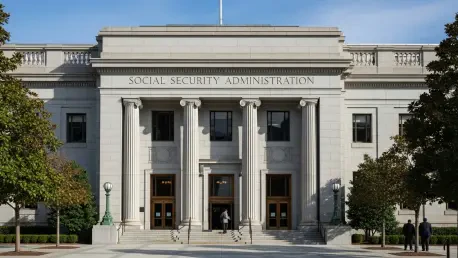Imagine calling a critical lifeline for Social Security benefits, only to be met with endless hold music, mounting frustration, and hours slipping away as you wait for assistance. For millions of Americans relying on the Social Security Administration (SSA), this scenario is a harsh reality, amplified by stark discrepancies in reported wait times for the agency’s 1-800 number. This roundup dives into the heated controversy surrounding SSA customer service, gathering insights from various stakeholders to explore whether leadership is transparent about performance metrics. The purpose is to present a balanced view of the challenges, opinions, and potential solutions, shedding light on an issue that affects some of the most vulnerable populations.
Diverse Voices on SSA Wait Time Discrepancies
Official Reports vs. Independent Findings
Official data from the SSA often paints a picture of progress, with claims of drastically reduced average wait times for callers seeking assistance. Some reports suggest a drop to mere minutes for hold durations, a statistic that has been touted as evidence of improved efficiency under current management. This narrative, however, stands in sharp contrast to independent surveys conducted by congressional offices, which indicate delays stretching far beyond official figures—sometimes by a factor of ten.
Critics argue that the methodology behind these official numbers may exclude significant factors, such as the time spent waiting for callbacks or interactions not involving live agents. This discrepancy has fueled skepticism among observers, who question whether the data reflects genuine service improvements or a curated version of reality. The gap between these accounts underscores a pressing need for clarity in how performance is measured and communicated to the public.
Union and Employee Perspectives on Data Reliability
Among frontline workers and union representatives, there is a palpable sense of doubt regarding the accuracy of wait time statistics. Many within the workforce suggest that the numbers might be influenced by selective reporting, potentially omitting critical delays experienced by callers. This perspective highlights a concern that the focus on favorable metrics could overshadow the true struggles faced by both employees and beneficiaries.
Furthermore, union voices emphasize the strain of understaffing, which they believe contributes significantly to service delays, regardless of what the reported figures show. Their insights point to a broader systemic issue, where the push for positive data may come at the expense of addressing root causes. Such concerns raise questions about whether the public is receiving a full and honest picture of SSA operations.
Operational Strategies Under Scrutiny
Staffing Reassignments: Quick Fix or Long-Term Harm?
A key strategy employed by SSA leadership involves reassigning field office staff to teleservice centers to handle call volumes, a move intended to reduce wait times. Some within the administration view this as a pragmatic solution, arguing that it directly tackles the backlog of inquiries and demonstrates adaptability in resource allocation. Proponents see this as a necessary step to manage immediate crises in customer service.
On the other hand, detractors from employee advocacy groups contend that this approach merely shifts the burden elsewhere, creating bottlenecks in other critical areas like in-person services. Delays in processing tasks such as issuing replacement Social Security cards have reportedly worsened, leaving beneficiaries in limbo. This divide in opinion reveals a tension between short-term relief and sustainable operational health, prompting debate on the best path forward.
Technological Shifts: Innovation or Obstacle?
The transition to new technological systems, including updated phone service platforms, has sparked mixed reactions among stakeholders. Certain leaders within the SSA frame these changes as a step toward modernization, with the potential to streamline communication and improve caller experiences over time. They argue that initial hiccups are a natural part of adapting to complex infrastructure updates.
Conversely, some former officials and technical analysts express concern that these transitions have introduced disruptions without adequate preparation or customization. Challenges in integrating workforce management tools have reportedly hindered efficiency, casting doubt on whether the technology is being leveraged effectively. This clash of viewpoints underscores the delicate balance between embracing innovation and ensuring readiness for implementation.
Leadership Dynamics and Accountability
Partisan Tones in Management Responses
Leadership responses to criticism over SSA performance have often taken a partisan edge, with current management pointing fingers at past administrations for operational shortcomings. Some defenders of the present strategy argue that inherited decisions, such as specific technological rollouts, set the stage for current struggles, and that recent efforts are correcting those missteps. This stance aims to redirect accountability to historical choices.
Critics, including legislative overseers, counter that such rhetoric distracts from addressing immediate challenges and fosters a culture of blame rather than collaboration. They suggest that focusing on past errors risks sidelining the urgent need for present-day reforms. This divide highlights a broader concern about whether leadership is prioritizing public service over political posturing.
Calls for Transparency and Oversight
Across various sectors, there is a growing chorus advocating for greater transparency in how SSA metrics are reported and verified. Congressional voices and public advocates alike stress the importance of independent audits to ensure that data reflects the true state of service delivery. Their position is rooted in the belief that accountability mechanisms are essential to rebuilding trust.
Additionally, some employee representatives push for increased dialogue between management and staff to align reported improvements with on-the-ground realities. They argue that involving frontline perspectives could lead to more accurate assessments of performance. This shared emphasis on oversight reflects a collective desire for reforms that prioritize honesty and effectiveness in serving the public.
Reflecting on the Path Ahead
Looking back, this exploration of SSA wait time controversies revealed a complex web of conflicting data, strategic trade-offs, and leadership challenges. The insights gathered from official reports, union critiques, independent surveys, and advocacy groups painted a picture of an agency at a crossroads, grappling with how to measure and achieve true progress. Each perspective contributed a unique angle, from skepticism over metrics to concerns about staffing and technology, illustrating the depth of the issue.
Moving forward, actionable steps emerged as a focal point. Stakeholders can push for independent reviews of SSA data to validate claims, while policymakers might consider allocating resources to address chronic understaffing. Exploring long-term technological solutions with proper testing phases could also prevent future disruptions. For those affected, staying engaged with legislative efforts and supporting employee-led initiatives offers a way to drive change, ensuring that the SSA evolves into a more reliable pillar of support for all who depend on it.









